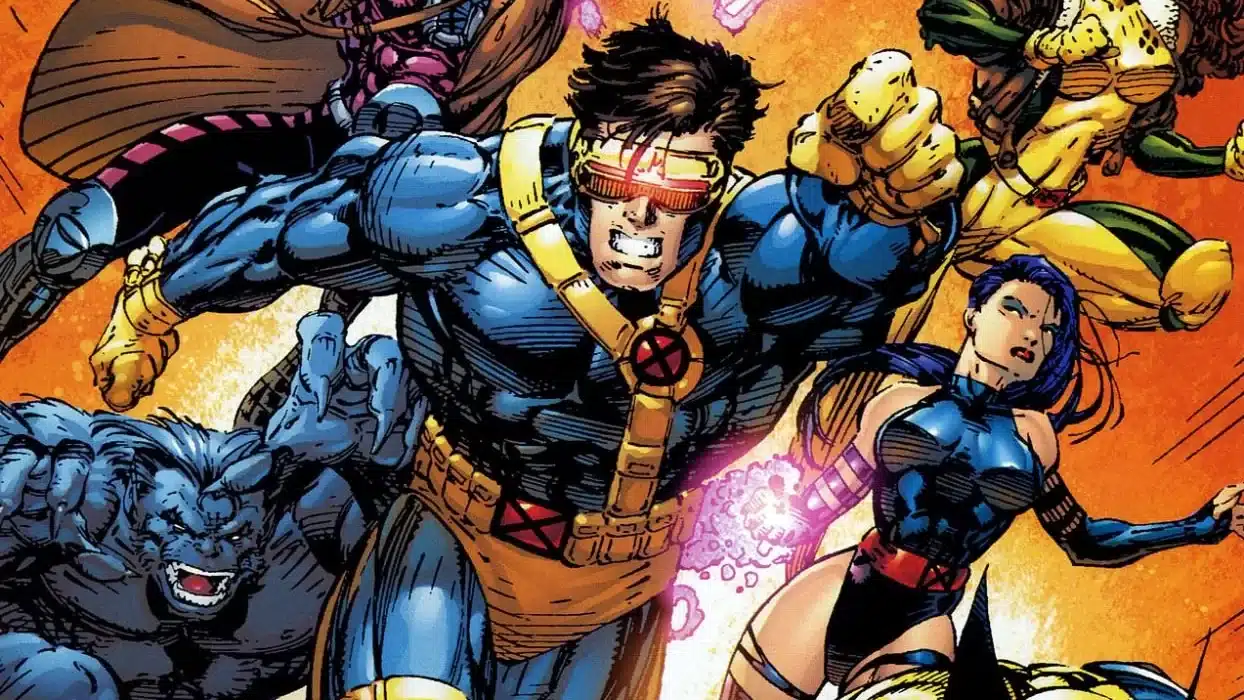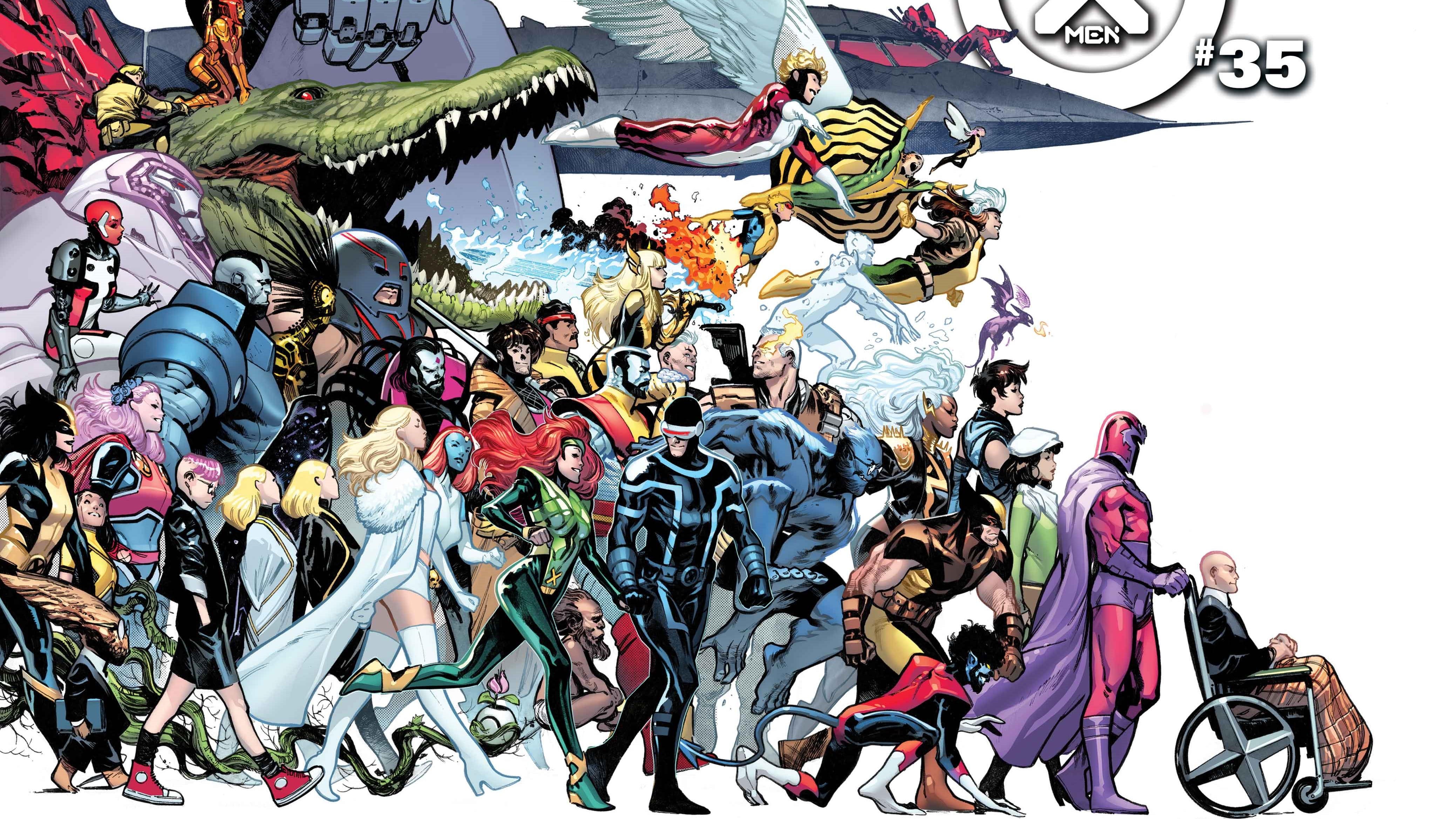This comes to us from Lincoln Crisler. Lincoln’ genre fiction credits include a contribution to IDW Publishing’s Robots vs Zombies anthology and editorship of Corrupts Absolutely?, an anthology of dark superhero fiction. A career non-commissioned officer in the United States Army, he currently lives and works in Europe with his wife and son.
The Age of Apocalypse rushes in with a bang. Bishop is our entry point; fitting, as we spent time with him just before the end. While this is the very same Bishop we last saw in X-Men #41, he barely remembers it, and everyone else we meet in X-Men: Alpha is not at all the same. I couldn’t imagine anyone flipping through the double-issue’s tour of the post-Apocalyptic Marvel Universe and not wanting more. We have many more questions than we do answers, just like Magneto’s X-Men when they rescue Bishop.
The X-Men themselves are at once familiar and radically different. Rogue, Storm, Iceman and Nightcrawler are comforting presences. Sunfire, Banshee and Dazzler are nice to see, as sparingly as they’re often used in the 616. Quicksilver is a welcome addition; he was only an X-Man in the mainstream universe for a brief time during Peter David’s X-Factor run, and was rapidly (pun intended) shunted back to his own dealings, and the Avengers’. He’s a mutant, and the son of Magneto; not having him on an X-team just seems like a waste. And pairing him off with Storm, seen more in-depth in the pages of Amazing X-Men, just makes sense. In our universe, they both frequently come off as very haughty personalities–nevermind that Storm’s always feels more deserved!

Then, there’s Sabertooth and Wild Child. To offer some perspective, readers in this era had, in the past couple years, come off a character arc that saw Victor Creed attempt to kill his son (Sabertooth Limited Series), semi-willingly check himself into the X-Mansion for treatment of his psychopathic tendencies (X-Men Unlimited #3) and team up with Banshee, Jubilee and the White Queen to save the future members of Generation X from the Phalanx (Phalanx Covenant: Generation Next). So it wasn’t completely impossible to fathom, but his kindly nature toward Wild Child (a complete wild card for fans who weren’t familiar with Alpha Flight) and Blink (dead in our universe after two issues due to events related to the Phalanx Covenant) is strangely reminiscent of his 616 rival’s frequent mentorship relationships with young female mutants. This particular iteration of Sabertooth and Blink, along with Morph, really resonated with fans in Astonishing X-Men and ended up being featured in another book, Exiles, years later.
Then there’s Magneto, the last bastion of the hopes and dreams of the young, late, Charles Xavier. We’d seen him take a face-turn in the mainstream universe, as an X-Man and as the headmaster of the New Mutants. His X-Men are a bit edgier than the team we’re used to seeing (the Age of Apocalypse is, essentially, everything one thinks about regarding 90s X-Men, cranked up to eleven), and surely that’s due to Erik’s influence as much as coming of age in the world around them. He’s an overarching presence at the start of all the monthly books: sending Nightcrawler to find Destiny (X-Calibre), Colossus, Kitty and their students to find Illyana (Generation NeXt), Gambit and his team to space in search of the M’kraan crystal (Gambit and the X-Ternals) and Weapon X and Jean Grey to help the human high council (Weapon X). He’s even later shown to have history with Forge, the mentor of escaped, Sinister-bred Nate Grey (X-Man), not to mention his more direct leadership in the Age of Apocalypse analogues to the two main books.

Of all the newly-revamped titles in the re-launch, one stands apart., that being Factor-X. While the other titles, for the most part, deal with the X-Men’s efforts to save humans from Apocalypse’s forces or implement pieces of the strategy Magneto forms after confronting Bishop, the X-Factor analogue features the bad guys–and, ironically, more original X-Men than any other title. It’s nice to see Cyclops and Havok playing off each other as brothers, as from Havok’s introduction in the late 60s right up until the 90s, they were rarely on a team together, and most of their interactions occurred during crossover events. The issues Alex sometimes has with mutant heroics and living up to Scott’s standards in our universe are only intensified in a world where they’ve been raised together–and by Sinister, in the bargain.
The other standout character in Factor-X is Hank McCoy, who works for Sinister and, by extension, Apocalypse. This Dark Beast is far more shocking than, say, the reversals seen in Sabretooth and Magneto. It’s written convincingly, but I don’t think anyone would have imagined in a million years Hank could play for the bad guys, which is likely the very reason the writers did it. After Scott and Hank, Warren is probably the most interesting of the reinvented O5. He makes appearances early in several titles, catering to both sides of the new world order and running a bar which serves as neutral ground, at least on the surface. While we’re on the topic of Angel’s Heaven, I’d like to drop a small piece of knowledge I had no idea about when I was thirteen and reading these for the first time: bar denizen Scarlett, the Age of Apocalypse’s nod to the concept of redheaded women being the downfall of Summers brothers, is none other than Quark from the 1980s Havok and Wolverine: Meltdown limited!

Finally, with the basic premise, character introductions and team missions out of the way, the other outstanding piece of the storyline’s first thrust are the different combinations of characters we get to see. Generation Next has most of the characters of its 616 counterpart, but with Colossus and Shadowcat in charge, and together in a way we’ve never seen fully realized. Strong Guy and Lila Cheney on a team together makes sense, but rounding out Gambit’s X-Ternals with Sunspot and Jubilee makes for an interesting dynamic. Sinister’s Factor-X team of enforcers are mostly sibling pairs, notably Cannonball and, not Husk from Generation X, but another sister, Elizabeth, with size-control powers we’ve never seen her exhibit in the 616. X-Man’s motley crew includes Mastermind, Sauron and Toad, all “chaotic good” in this reality, along with Siryn and Forge. Juggernaut as a solemn monk. Multiple Man as an entire priesthood devoted to Apocalypse.

The more you already know about the X-Men, the more treats the Age of Apocalypse has in store for you. There are only a couple of quibbles that stand out, and they may not even matter to every reader. Having Magneto paired off with Rogue, who’s probably in her early twenties, can seem a little creepy. Also, similar observations can be made about Wolverine and…practically anyone. Additionally, Psylocke is conspicuous by her absence; the only major X-Men character not to be reinvented for the event. Her brother, Brian, is present as a member of the Human High Council, highlighting matters further. Another member of the Council is an Emma Frost who’s been lobotomized to remove her powers. She could have easily filled another role, and Elisabeth placed alongside her brother.
By the time we reach the halfway point, the X-Men have secured the evacuation of humans from at least a portion of Apocalypse’s America, Sinister has betrayed Apocalypse and linked up with Nate Grey, Gambit’s team is deep in Shi’ar space, and Colossus’ team has breached the Seattle Core.

But also, Magneto’s efforts have attracted the attention of En Sabah Nur, and the X-Men will soon be tested like never before.
Zachary Jenkins runs ComicsXF and is a co-host on the podcast “Battle of the Atom.” Shocking everyone, he has a full and vibrant life outside of all this.






